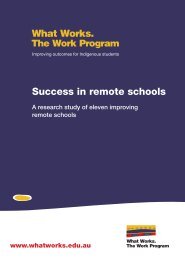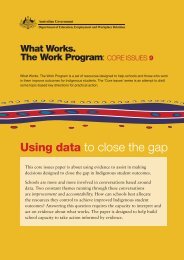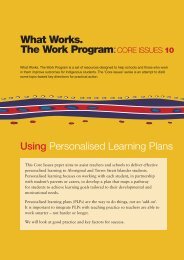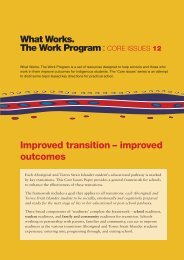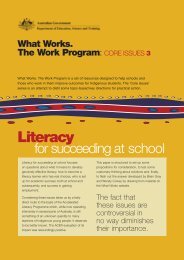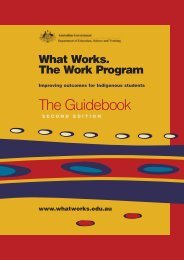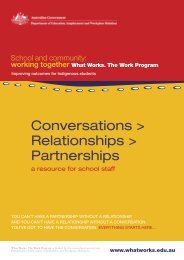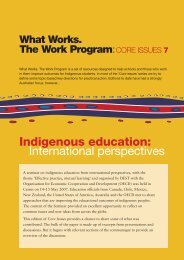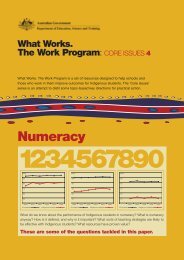Bound for Success Scope and Sequence Statements
Bound for Success Scope and Sequence Statements
Bound for Success Scope and Sequence Statements
- No tags were found...
You also want an ePaper? Increase the reach of your titles
YUMPU automatically turns print PDFs into web optimized ePapers that Google loves.
ENGLISHWriting Imaginative TextsIn Years 1, 2 <strong>and</strong> 3 students write simple stories in print <strong>and</strong> electronic mediums, using those they have read <strong>and</strong> heard asmodels.In Years 4, 5 & 6 students write imaginative texts in, print <strong>and</strong> electronic mediums, that largely draw on the students’ owndirect experience of the world. These texts may include stories, simple poems <strong>and</strong> scripts.In Years 7 & 8 students write imaginative texts that contain ideas <strong>and</strong> in<strong>for</strong>mation dealing with their personal views of theworld. These texts may include simple adventure fantasy, horror <strong>and</strong> ghost stories, myths, legends, ballads <strong>and</strong> play scripts.In Years 9 & 10 students write in print <strong>and</strong> electronic mediums, that contain personal, social <strong>and</strong> cultural ideas <strong>and</strong> issuesrelated to their own lives <strong>and</strong> communities, <strong>and</strong> their views of their exp<strong>and</strong>ing world. These texts may include short stories,anecdotes, plays, poetry, <strong>and</strong> personal letters.In Year 1the student:In Year 2the student:In Year 3the student:In Year 4the student:In Year 5the student:In Year 6the student:In Year 7the student:In Year 8the student:In Year 9the student:In Year 10the student:underst<strong>and</strong>s that:o texts can entertain <strong>and</strong>in<strong>for</strong>mo stories have characters<strong>and</strong> eventso simple stories have astructureunderst<strong>and</strong>s that:o texts can entertain <strong>and</strong>in<strong>for</strong>mo stories have characters<strong>and</strong> key eventso stories have a structureunderst<strong>and</strong>s that:o texts have purposes toentertain or in<strong>for</strong>m anaudienceo stories have characters,setting, ploto imaginative texts have astructureunderst<strong>and</strong>s that writers:o consider their purpose <strong>for</strong>writingo consider thecharacteristics of theaudience when selectingsubject matter (e.g. <strong>for</strong> apicture book <strong>for</strong> prepstudents <strong>and</strong> <strong>for</strong> a book<strong>for</strong> Year 7 students)o develop narrativesthrough the plot <strong>and</strong>descriptions of settings,characters, event <strong>and</strong>thingsunderst<strong>and</strong>s that writers:o consider their purpose <strong>for</strong>writing, including topersuade, entertain, orin<strong>for</strong>mo consider the interests ofthe audience whenselecting subject matterwithin a chosen topico can explore their ownideas <strong>and</strong> feelings throughthe characters <strong>and</strong>situations they createo can represent characters<strong>and</strong> events in particularways by including oromitting in<strong>for</strong>mation <strong>and</strong>making particularlanguage choicesunderst<strong>and</strong>s that writers:o select subject matteraccording to the purposeof their writing <strong>and</strong>audienceo can draw on their ownideas <strong>and</strong> on the subjectmatter <strong>and</strong> <strong>for</strong>ms of textsthey have read <strong>and</strong>viewed when developingcharacters, settings <strong>and</strong>plotunderst<strong>and</strong>s that writers:o select subject matterwithin a chosen topicaccording to purpose <strong>and</strong>audienceo can draw on their ownknowledge, experiences,thoughts <strong>and</strong> feelingso can draw on the subjectmatter <strong>and</strong> <strong>for</strong>ms of textsthey have heard, read <strong>and</strong>viewedunderst<strong>and</strong>s that:o selection of subject matteris dependent on contexts,purpose <strong>and</strong> audienceo ideas <strong>and</strong> issues canextend beyond theimmediate ploto writers can be influencedby the knowledge, values<strong>and</strong> practices of differentcultures (e.g. youthculture, traditionalcultures)underst<strong>and</strong>s that:o imaginative texts canmove <strong>and</strong> persuadeo ideas <strong>and</strong> issues canextend beyond theimmediate plot with mainideas developed throughthe interconnections ofplot, settings <strong>and</strong>characterso writers can express views<strong>and</strong> values other than theirownunderst<strong>and</strong>s that:o writers use theconventional plots,settings, characters <strong>and</strong>resolutions associatedwith different text types(e.g. horror, adventure,romance) to positionaudienceso writers choose how toposition their readers bydrawing on theknowledge, values <strong>and</strong>practices of groups toshow differentperspectives or to servecertain interests (e.g.Parvana by DeborahEllis)writes stories that:o include events insequenceo include people, places,objects <strong>and</strong> events relatedto their personalexperienceswrites stories that:o include brief descriptionsof setting <strong>and</strong> characterso include a series of looselyconnected events oractionso conclude with a simpleendingwrites stories that:o introduce characters <strong>and</strong>provide a brief descriptionof settingo <strong>for</strong>mulate a storyline of afew sequenced events <strong>and</strong>create a complicationo include brief descriptionsof familiar characters,places <strong>and</strong> thingso attempt an ending, oftenas a resolutionwrites stories that:o provide a brief descriptionof setting, includingplaces <strong>and</strong> objectso develop characters usingdescriptionso use dialogueo <strong>for</strong>mulate a storyline ofsequenced events <strong>and</strong>create a complicationo create an ending, often asa resolutionwrites stories that:o provide a description of asetting <strong>and</strong> characterso use dialogue to enhancecharacter development<strong>and</strong> meaningo develop a storyline ofsequenced eventsinvolving complications<strong>and</strong> resolutions withrelevant detailso create an ending whichdraws together elementsof the storyline,sometimes in a resolutionwrites stories that:o develop characters <strong>and</strong>setting using descriptions<strong>and</strong> dialogueo create characters withpersonalities, throughdialogue <strong>and</strong> descriptionsof feelings <strong>and</strong> behaviouro develop a storyline ofsequenced eventssupported by relevantdetails involvingcomplications, resolutions<strong>and</strong> conclusiono use evaluative words (e.g.nervously, lucky,challenging)o use some humour toentertain their audienceo use subject matter chosento appeal to certaingroupso reflect consideration ofsome social justiceimplications of the waysthat people, places, events<strong>and</strong> things are representedwrites stories that:o use ideas, details <strong>and</strong>events that are relevant tothe storylineo develop characterisationthrough descriptions,actions <strong>and</strong> dialogueo create characters withfeelings <strong>and</strong> personalitiesbeyond traditionalcharacterso include some evaluativecomments on thesignificance of an event(e.g. it was like a baddream)o can use humour toentertain their audienceo choose aspects of subjectmatter to representpeople, places, events <strong>and</strong>things in ways that appealto certain groupso reflect consideration ofthe social justiceimplications of the waysthat people, places, events<strong>and</strong> things are representedwrites stories that:o draw on conventions ofnarrative including timeorder; characterisation,description <strong>and</strong> imagery,creating atmosphere,reflections/evaluations ofactionso develop a series ofcomplications with aclimax <strong>and</strong> resolutiono use dialogue to constructrelationships betweencharacterso explore challenging ideas<strong>and</strong> ethical dilemmasthrough the constructionof actions, speech,thoughts <strong>and</strong> feelings ofthe characterso experiment with usingparody to create humouro reflect selective choices toposition readers/viewers incertain ways whenconstructingrepresentations ofcharacters, settings <strong>and</strong>plotwrites stories that:o develop sustained textswith attention to timeorder, characterisation,consistent narrative pointof view <strong>and</strong> developmentof a resolutiono use dialogue to constructrelationships betweencharacters <strong>and</strong> to furtherthe narrativeo create characters <strong>and</strong>situations which exploreethical dilemmas, <strong>and</strong>which move beyondstereotypes orexpectationso use references to othertexts <strong>and</strong> parody to extendmeaning <strong>and</strong> createhumourwrites stories that:o develop sustained textswith attention to timeorder, characterisation,consistent narrative pointof view <strong>and</strong> developmentof a resolutiono use dialogue to constructrelationships betweencharacters <strong>and</strong> to furtherthe narrativeo create characters <strong>and</strong>situations which exploreethical dilemmas, <strong>and</strong>which move beyondstereotypes orexpectationso use references to othertexts <strong>and</strong> parody to extendmeaning <strong>and</strong> createhumourknows <strong>and</strong> uses:• basic punctuationincluding capitals, fullstops <strong>and</strong> question marksto signal the beginning<strong>and</strong> end of sentences.• the aspects of spellingknows <strong>and</strong> uses:• basic punctuationincluding capitals, fullstops <strong>and</strong> question marksto signal the beginning<strong>and</strong> end of sentences• the aspects of spellingknows <strong>and</strong> uses:• basic punctuationincluding capitals to signalnames <strong>and</strong> the beginningof a sentence; full stops,question marks <strong>and</strong>exclamation marks tosignal the end of aknows <strong>and</strong> uses:• punctuation including- commas to mark clauses(as in Eats, Shoots <strong>and</strong>Leaves by Lynne Truss),- apostrophes incontractions <strong>and</strong> toknows <strong>and</strong> uses:• punctuation including- commas to mark clauses- apostrophes incontractions <strong>and</strong> toshow ownership- speech marks <strong>for</strong> directspeechknows <strong>and</strong> uses:• punctuation <strong>for</strong> directspeech (quotation marks,comma, full stop/questionmark/exclamation mark)• the aspects of spellingspecified in the Spellingknows <strong>and</strong> uses:• punctuation includingquotation marks to signaldirect speech <strong>and</strong> directquotes• the aspects of spellingspecified in the Spellingknows <strong>and</strong> uses:• punctuation indicatingdifferentiation of direct<strong>and</strong> reported speech, <strong>and</strong>direct quotes• the aspects of spellingspecified in the Spellingknows <strong>and</strong> uses:• punctuation includingconventions of quoting<strong>and</strong> referencing• the aspects of spellingspecified in the Spellingknows <strong>and</strong> uses:• punctuation including- conventions of quoting<strong>and</strong> referencing- colon <strong>and</strong> semicolons inextended lists.• the aspects of spelling<strong>Bound</strong> <strong>for</strong> <strong>Success</strong> <strong>Scope</strong> <strong>and</strong> <strong>Sequence</strong> <strong>Statements</strong> Page8 Working Document Semester One V2 - 2007



